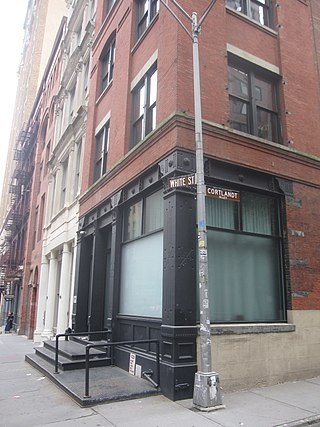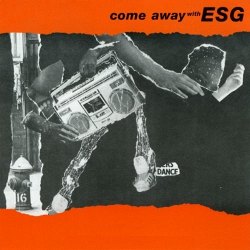Related Research Articles

Disco is a genre of dance music and a subculture that emerged in the 1970s from the United States' urban nightlife scene. Its sound is typified by four-on-the-floor beats, syncopated basslines, string sections, brass and horns, electric piano, synthesizers, and electric rhythm guitars.
New wave is a music genre that encompasses pop-oriented styles from the late 1970s through the 1980s. It is considered a lighter and more melodic "broadening of punk culture". It was originally used as a catch-all for the various styles of music that emerged after punk rock, including punk itself. Later, critical consensus favored "new wave" as an umbrella term involving many popular music styles of the era, including power pop, synth-pop, alternative dance, and specific forms of punk that were less abrasive. It may also be viewed as a more accessible counterpart of post-punk.
No wave was an avant-garde music genre and visual art scene which emerged in the late 1970s in Downtown New York City. The term was a pun based on the rejection of commercial new wave music. Reacting against punk rock's recycling of rock and roll clichés, no wave musicians instead experimented with noise, dissonance, and atonality, as well as non-rock genres like free jazz, funk, and disco. The scene often reflected an abrasive, confrontational, and nihilistic world view.
Synth-pop is a music genre that first became prominent in the late 1970s and features the synthesizer as the dominant musical instrument. It was prefigured in the 1960s and early 1970s by the use of synthesizers in progressive rock, electronic, art rock, disco, and particularly the Krautrock of bands like Kraftwerk. It arose as a distinct genre in Japan and the United Kingdom in the post-punk era as part of the new wave movement of the late 1970s.
A video jockey is an announcer or host who introduces music videos and live performances on commercial music television channels such as MTV, VH1, MuchMusic and Channel V.

Robert Thomas Christgau is an American music journalist and essayist. Among the most well-known and influential music critics, he began his career in the late 1960s as one of the earliest professional rock critics and later became an early proponent of musical movements such as hip hop, riot grrrl, and the import of African popular music in the West. Christgau spent 37 years as the chief music critic and senior editor for The Village Voice, during which time he created and oversaw the annual Pazz & Jop critics poll. He has also covered popular music for Esquire, Creem, Newsday, Playboy, Rolling Stone, Billboard, NPR, Blender, and MSN Music, and was a visiting arts teacher at New York University. CNN senior writer Jamie Allen has called Christgau "the E. F. Hutton of the music world – when he talks, people listen."
Danceteria was a nightclub that operated in New York City from 1979 until 1986 and in the Hamptons until 1995. The club operated in various locations over the years, a total of three in New York City and four in the Hamptons. The most famous location was likely the second, a four-floor venue at 30 West 21st Street in Manhattan that served as the location for the disco scene in the film Desperately Seeking Susan.

The Mudd Club was a nightclub located at 77 White Street in the TriBeCa neighborhood of Lower Manhattan in New York City. It operated from 1978 to 1983 as a venue for post punk underground music and no wave counterculture events. It was opened by Steve Maas, Diego Cortez and Anya Phillips.
Dance-punk is a post-punk subgenre that emerged in the late 1970s, and is closely associated with the disco, post-disco and new wave movements. The genre is characterized by mixing the energy of punk rock with the danceable rhythms of funk and disco. It was most prominent in the New York City punk movement.

Nightclubbing is the fifth studio album by Jamaican singer and songwriter Grace Jones, released on 11 May 1981 by Island Records. Recorded at Compass Point Studios with producers Alex Sadkin and Island Records' president Chris Blackwell, as well as a team of session musicians rooted by rhythm section Sly and Robbie, the album marked her second foray into a new wave style that blends a variety of genres, including reggae, art pop, dub, synth-pop and funk. The album has cover versions of songs by Bill Withers, Iggy Pop, Astor Piazzolla, and others, and original songs, three of which were co-written by Jones.

ESG is an American rock band formed in the South Bronx in 1978. ESG has been influential across a wide range of musical genres, including hip hop, and dance-punk. The band's track "UFO" is one of the most sampled songs in history.

Simon Reynolds is an English music journalist and author who began his professional career on the staff of Melody Maker in the mid-1980s. He has since gone on to freelance and publish a number of full-length books on music and popular culture, ranging from historical tomes on rave music, glam rock, and the post-punk era to critical works such as Retromania: Pop Culture's Addiction to Its Own Past (2011).

Come Away with ESG is the 1983 debut album by American rock band ESG. Released by 99 Records, the album incorporates songs from ESG's first EPs, ESG and ESG Says Dance to the Beat of Moody.
Ira Silverberg is an American editor and consultant to writers, artists, publishers, funders, and non-profit arts organizations. He is a member of the adjunct faculty of the Columbia University School of the Arts, MFA Writing Program.
New Pop is a loosely defined British-centric pop music movement consisting of ambitious, DIY-minded artists who achieved commercial success in the early 1980s through sources such as MTV. Rooted in the post-punk movement of the late 1970s, the movement spanned a wide variety of styles and artists, including acts such as Orange Juice, the Human League, and ABC. The term "rockist", a pejorative against people who shunned this type of music, coincided with and was associated with New Pop.
NIGHT is an art/fashion/music/literature/nightlife periodical co-edited by Anton Perich and Robert Henry Rubin. Established in Manhattan, New York, in 1978 the magazine was created during the punk-new wave-disco nightclub era of among others; Studio 54, Xenon, Club A, Regine's, The Continental, Hurrah's, Danceteria, and the Mudd Club. Today the magazine continues to focus on the beautiful, the exclusive, the intelligent and the controversial. Among the contributors have been Charles Plymell, Helmut Newton. Taylor Mead, Harold Stevenson, Victor Bockris, Lee Klein, Charles Henri Ford and countless others.

The World was a large nightclub in New York City, which operated from the early 1980's until 1991 at 254 East 2nd Street, in Manhattan's East Village neighborhood. The venue, which included a secondary establishment called "The It Club," was housed in a former catering hall and theater. The World attracted a clientele that was economically, racially, and sexually diverse, and included artists, celebrities, and fashion designers, such as Keith Haring, Afrika Bambaataa, Madonna, Brooke Shields, Prince, Stephen Sprouse, RuPaul, and Carolina Herrera, together with banjee boys and members of voguing houses

"House of Jealous Lovers" is a song by American indie rock band the Rapture. It was released as the lead single from their second studio album, Echoes, in March 2002, through DFA Records in the US and Output Recordings in the UK. It was eventually re-released in 2003.
Haoui Montaug was a doorman of the New York City nightclubs Hurrah, Mudd Club, Danceteria, Studio 54, and the Palladium. Montaug also ran the roving cabaret revue No Entiendes which showcased among others a young Madonna and early performances by the Beastie Boys.
Scott B and Beth B were among the best-known New York No Wave underground film makers of the late 1970s and early 1980s.
References
- ↑ Post, H.: "New Wave After Dark: The Big Clubs, New York, Pg. 55, Nov. 3, 1980.
- ↑ New York Rock: From the Rise of The Velvet Underground to the Fall of CBGB by Steven Blush
- ↑ Shapiro, P.: Turn the Beat Around: The Secret History of Disco, page 256. Faber & Faber, October 2006.
- ↑ Christgau, Robert: "The Pazz & Jop Critics' Poll (Almost) Grows Up", Village Voice, Jan. 28, 1980.
- ↑ Shore, M.: The Rolling Stone Book of Rock Video, pg. 73, Quill, 1984.
- ↑ Haden-Guest, Anthony: "The gang of new york", The Observer, 18 July 2004.
- ↑ Martin, D.: "Arthur Weinstein, Starter of Nightclubs, Dies at 60", The New York Times, July 16, 2008.
- ↑ Palmer, R.: "New York Rock Bands Excite London", The New York Times, February 20, 1981.
- ↑ "The Pazz & Jop Critics' Poll (Almost) Grows Up", Village Voice, Jan. 28, 1980.
- ↑ Gussow, Mel (17 April 1978). "The Neon Woman' by Eyen is Staged". The New York Times.
- ↑ "Search - Lortel Archives". www.lortel.org. Archived from the original on 2016-03-07.
- ↑ Tucker, R.: "My New York: Sid & Nancy", The New York Post, July 27, 2010.
- ↑ Pegg, Nicholas: The Complete David Bowie, Reynolds & Hearn, 2000.
- ↑ "Haoui Montaug; Disco Doorman, 39". The New York Times. p. 25.
- Shapiro, P. Turn the Beat Around: The Secret History of Disco, Faber & Faber, October 2006.
- Orth, Maureen: "The Beat Comes East," pg. 39, New York, 26 March 1979.
- Turcotte, Bryan Ray, and Miller, Christopher T., Fucked Up + Photocopied: Instant Art of the Punk Rock Movement, Gingko Press, August 1999.